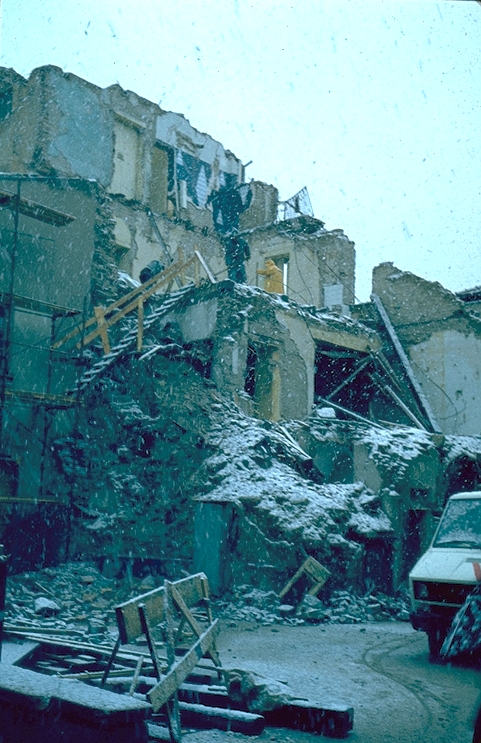A (post-earthquake) Christmas story
By David Alexander, on 23 December 2021
In 1980, as Christmas approached in the Southern Apennines, the temperature fell and it began to snow. December 23rd dawned with a leaden grey sky and frost everywhere. I was getting used to being evacuated and nominally homeless. The magnitude 6.8 earthquake that had occurred exactly one month earlier had taken the roof off the house in which I had been living. I had moved in with a family on the sixth floor of an apartment block. It was not a happy place to be when aftershocks came along and the whole building swayed back and forth.
I decided to go and see for myself what the situation was in upper Basilicata region. I drove along deserted roads and then up into the highlands towards San Fele, a town in splendid isolation at the end of 20km of typically winding mountain roads. Liquefaction and seismically-induced landslides had bent the highway into some very odd contortions, but it was just about passable.
At a certain point, far from the nearest town, an extraordinary sight met my eyes. There in front of me was a farmhouse. It had been a traditional stone building, rather than a modern ferro-concrete one, but the earthquake had reduced it to large pile of rubble. As the courtyard outside the building was full of people and animals, it appeared that those who lived there had survived. In the corner there was an olive-green tent supplied by the army. In the middle there was an enormous bonfire that seemed to consist of the furniture that had been salvaged from the house. The fire was crackling away and flames were roaring up into the sky, while flakes of snow gently fell on the scene. In a circle around the fire there were the farmer, his wife, his children, an elderly couple, cats, dogs, geese, chickens, cows, sheep and goats. They were all staring moodily into the flames, desperate for some warmth.
Disaster specialists tend to photograph everything they see when they are out in the field, but this time I had not got the heart to point my camera at this extraordinary tableau.
San Fele and the other towns–Bella, Muro Lucano, Balvano, Ruvo del Monte–were silent and deserted. Their streets were full of a mixture of rubble, wooden buttressing and elaborate meshes of steel scaffolding. As the weather was worsening and night was beginning to fall, I beat a hasty retreat for fear of being trapped by snow and ice on the roads.
It was a hard winter and a sombre Christmas for the 280,000 people who had lost their homes in the earthquake. Snow and ice were followed as soon as the temperature rose by rain and mud. But there were some inspiring moments. Night-time journeys on the train that wound its way along the deep crevice of the Basento Valley revealed some extraordinary sights. One that I particularly remember was a field of olive trees. The field was white with a thick covering of snow and the trees glinted and sparkled as the moonlight reflected off the frost that covered them and icicles that hung from their branches. It was nevertheless a relief when Spring brought kinder weather to the survivors’ camps.
David Alexander is Professor of Risk and Disaster Reduction at IRDR.
One Response to “A (post-earthquake) Christmas story”
- 1
 Close
Close



Tempat main slot yang aman, nyaman dan terpercaya cuma NAGA EMPIRE